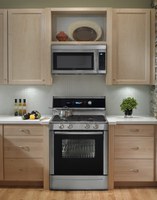Prairie Fare: “Microwave It” Guide Teaches Safe Food Handling and Provides Recipes
(Click the image below to view a high-resolution image that can be downloaded)
By Julie Garden-Robinson, Food and Nutrition Specialist
NDSU Extension Service
“The microwave is on fire!” one of my students exclaimed.
I quickly looked at the sparking spectacle in the back of the room. Several students were staring at the oven. I was expecting a raging inferno. I ran back and turned off the oven.
The situation happened years ago when I was a young graduate student teaching a food preparation class.
The event wasn’t quite as catastrophic as I was expecting.
Someone had put a plastic bread bag in the microwave oven with the metal twist tie attached. The sparking from the twist lit the plastic on fire. The fire was extinguished quickly, and the oven still worked.
Suffice it to say, my students “learned by doing” that day. Anyway, they learned not to put metal twist ties in the microwave oven.
The first countertop microwave oven appeared in 1967. Today, most households have a microwave oven and use it nearly every day.
Microwave ovens cook food using a magnetron to convert electric power to very short radio waves of about 2,450 megahertz. At this frequency, water, fats and sugars absorb the waves and vibrate very fast to create high temperatures that cook the food.
Do you ever use margarine tubs, take-out containers, foam trays or brown paper bags to heat food in your microwave? These are considered unsafe for microwave oven use unless they are labeled “microwave safe.” The concern is that the container could melt and leach chemicals into your food.
Instead, reheat foods in glass, ceramic cookware and those labeled safe for microwave use. Microwave-safe plastic wraps, wax paper, cooking bags, parchment paper and white microwave-safe paper towels also are considered safe for microwave use. However, be sure to discard containers that hold prepared microwavable meals after you use them because they are meant for one-time use.
Do you know the wattage of your microwave oven? Cooking times vary depending on the wattage of your oven. Follow the package label or recipe instructions to be sure you are heating microwaveable foods properly.
Have you ever tried the “marshmallow test” to determine hot spots in your microwave oven? Microwave ovens often have hot and cold spots.
Because of the uneven cooking that can occur, be sure to rotate the container during the cooking process and stir the food if possible, even if your microwave oven has a turntable. Covering the dish with a microwave-safe lid or plastic wrap also promotes even cooking.
After heating food in a microwave oven, be sure to allow a standing time of at least three minutes. During the standing time, the food continues to cook. Many microwaveable packaged foods list an endpoint temperature, such as 165 F. Measure the temperature using a food thermometer to ensure that the food has reached a safe internal temperature.
You can view the marshmallow test in action and find out how to determine the wattage of your microwave using a new learning tool Nebraska Extension and NDSU Extension developed. Visit http://tinyurl.com/zmagmicro to see the videos and read the interactive online “Microwave It” magazine (zmag). Complete the survey at the end to be eligible for prize drawings.
If you are curious about the “marshmallow test,” here is how to do it. Use a microwaveable plate or flip the turntable upside down so it does not rotate. Line the plate or turntable with miniature marshmallows. Place in the microwave oven, then set the timer for one minute. Watch carefully. If the marshmallows begin to burn, turn off the microwave oven. The marshmallows that expand first show where your microwave oven’s hot spots are. Remember that uneven cooking (hot and cold spots) can lead to undercooked food that is unsafe to eat.
Here is one of the many easy, healthful recipes featured in the “Microwave It” zmag.
Apple Cinnamon Microwave Oatmeal
2 c. rolled oats*
4 c. low-fat milk
1/8 tsp. salt
2 unpeeled apples, chopped
1 tsp. vanilla
1 tsp. ground cinnamon
(*) Old-fashioned oats will provide a chewier texture, while quick oats will result in a smoother texture.
Mix together all ingredients in a large microwave-safe bowl. Microwave on high for five to six minutes, stirring every two minutes, until oats are soft and most of the liquid has been absorbed. Spoon into bowls and serve while hot. Top with brown sugar if desired.
Makes five servings. Each serving has 260 calories, 6 grams (g) of fat, 11 g of protein, 45 g of carbohydrate, 150 milligrams of sodium and 20 percent of the daily value for calcium.
(Julie Garden-Robinson, Ph.D., R.D., L.R.D., is a North Dakota State University Extension Service food and nutrition specialist and professor in the Department of Health, Nutrition and Exercise Sciences.)
NDSU Agriculture Communication – April 17, 2014
| Source: | Julie Garden-Robinson, (701) 231-7187, julie.garden-robinson@ndsu.edu |
|---|---|
| Editor: | Rich Mattern, (701) 231-6136, richard.mattern@ndsu.edu |


